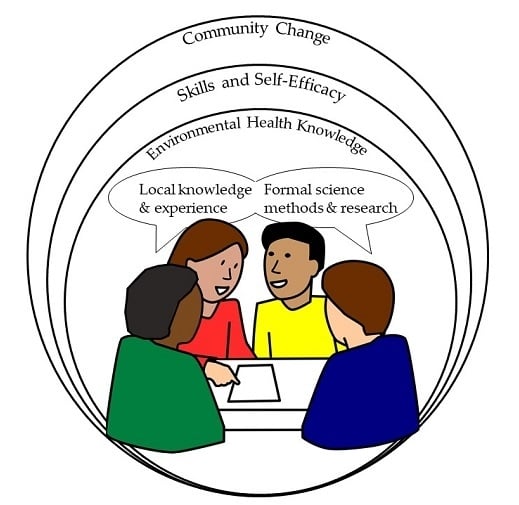Increasing Environmental Health Literacy through Contextual Learning in Communities at Risk
Abstract
1. Introduction
2. Materials and Methods
2.1. Contextual Training Design
2.2. Partner Community Selection
2.3. Participant Recruitment
2.4. Training Facilitation
- Simultaneous translation during the lectures, with bilingual facilitator-scientists acting as translators.
- Dual projection of slide presentations in English and Spanish (all slides were identical in content and presented and projected in English and Spanish).
- Spanish language kit and manual during sampling hands-on education, and bilingual educators on site to provide one-on-one assistance.
- English and Spanish take-away copies of all slides and supplemental education materials provided in a binder [43] (Supplemental Materials).
2.5. Research Methods
2.6. Data Analysis Methods
- Motivation to learn was measured through four questions on the pre-program participant survey asking participants why they chose to attend, what they hoped to gain from the program, about their current rainwater harvesting practices, and what prior training on similar topics they may have received. Participant responses were coded for common themes, and occurrence of themes were aggregated to understand common motivations for choosing to attend the training.
- Attitude towards the environment was measured by two closed-ended survey questions about preference towards environmental protection and environmental investment. Participant responses were aggregated and evaluated as a group, and pre-post change was evaluated per participant.
- Environmental science knowledge was measured through seven open-ended and six closed-ended survey questions. Responses to four multiple choice questions were scored for level of knowledge. Responses to seven short answer questions were analyzed for both specific knowledge concepts, using qualitative coding for themes; and, for level of knowledge, by assigning a 0 (no knowledge), 1 (partial knowledge), 2 (baseline knowledge), or 3 (advanced knowledge) to each response. Coding rules for level of knowledge were specific to the question being analyzed. Table 4 describes the coding rules and example responses to one open-ended survey question. A dependent samples t-test was performed per question to assess significant change in participants’ mean level of environmental science knowledge for each topic area. Because participants who scored below baseline knowledge pre-training had more opportunity for learning gains, an additional dependent samples t-test was performed to look at knowledge change in those participants only. For this test, questions that could only be scored right or wrong were omitted.
- Skills for environmental health comprised a significant portion of training content. Three survey questions asked participants about specific actions they could take to (1) “curb the effects of climate change”, (2) “make a positive impact on water reliability in the future”, and (3) “protect the environment, conserve water, conserve energy, and protect the health of your family and neighbors”. Responses to these questions were coded for categories of environmental health action. The number of participants describing each skill category was compared pre- and post-training. Additionally, specific strategies described per participant pre- and post-training were averaged per participant and compared using a dependent samples t-test.
- Motivation for environmental action was assessed by eleven Likert scale items. These items were modified from literature provided by the Cornell Lab of Ornithology [45], who use a similar measurement tool with their citizen science program participants. Five items were designed to measure external motivation for environmental action, and six items were designed to measure internal motivation. Following the recommended analysis methodology from Cornell, the sum of external motivation scores were subtracted from the sum of internal motivation item scores, to calculate an overall motivation score per participant. Positive scores indicate predominantly internal motivations, while negative scores indicate predominantly external motivations. A dependent samples t-test was used to analyze pre-post change in motivation for environmental action overall. A Wilcoxon Signed-Rank test was used to test for significance between the mean pre- and mean post-survey scores by community.
- Self-efficacy (SE) is defined as a person’s belief in their own capabilities [46]. SE was measured using a Likert scale in the categories of “SE for learning science” (six items), “SE for doing science” (four items), and “SE for environmental action” (12 items). These items were modified from the literature provided by Cornell Lab of Ornithology [45], and analyzed using their suggested methodology. Four items on the survey were worded in reverse (statements reflected lack of SE), were therefore scored in reverse. From a total dataset of 41 paired surveys, 12 “high self-efficacy” participants were removed who met the criteria of having 15 or more responses of a 4 or 5 on the 1–5 Likert scale, to isolate the participants with an opportunity for change. Using this “low pre SE” dataset (n = 29), the mean SE for each SE category was calculated pre- and post-training for each participant, and were analyzed using the Wilcoxon Signed Rank test to assess differences between communities.
- Community change is defined broadly here to include relationship building, network building, collaboration, educational advocacy, and political advocacy. Participant responses to three survey questions and reflections from facilitator-scientists were analyzed for community action themes. Additionally, the individual decision by a participant to further invest their time and effort as an environmental citizen scientist post-training was considered to be a community-level action, as participation in co-created citizen science involves translating results into responsive action as part of the study design [28].
- Participant experience was assessed through qualitative coding for themes in responses to four open-ended survey questions related to participant perception of benefits of the training, their intentions to harvest rainwater, and suggestions for training improvements and future trainings.
- Facilitator-scientist experience was assessed through an open-ended survey via email with four of the facilitator-scientists, all who were involved in the design and agenda planning for the trainings. Survey questions asked for general reflections, specific surprises or challenges in the trainings, and for specific anecdotes of participants connecting content to local knowledge or life experiences.
3. Results
3.1. Participant Demographics
3.2. Participant Motivation and Attitude
“We dug a cistern and have harvested rainwater for 30 years. We live in the canyon where Dioxin/Agent Orange was sprayed in the Pinal [Mountain]s 1965–1969. Many problems associated with that. Interested in present contamination, also because we grow our own vegetables.”
3.3. Environmental Science Knowledge
3.4. Self-Efficacy
3.5. Skills for Environmental Health Action
3.6. Community Change
3.7. Reflections from Participants
“An appreciation of how things are connected. How these connections can be identified & monitored for protecting our public health”—Globe/Miami participant
“Calentamiento global, el peligro de algunos microorganismos. Importancia de conservar” (Global warming, the risk of some microoganisms. Importance of conservation.)—Tucson participant
“Deeper understanding of how and why CC [climate change] is occurring, stronger appreciation for the efforts of the scientific community, understanding and appreciation for the idea of “democratized science”—Hayden/Winkelman participant
3.8. Reflections from Facilitator-Scientists
3.8.1. Formative Evaluation of Materials
3.8.2. Gaining Local Knowledge to Inform Research
3.8.3. Building Relationship and Co-Creating Hope with Community Members
4. Discussion
4.1. Study and Survey Design
4.2. Contextual Learning and Collaborative Relationships
4.3. Environmental Health Literacy and Community Action
4.3.1. Knowledge and Awareness
4.3.2. Skills and Self-Efficacy (SE)
4.3.3. Community Change
5. Conclusions
Supplementary Materials
Author Contributions
Funding
Acknowledgments
Conflicts of Interest
References
- National Environmental Justice Advisory Council (NEJAC). Ensuring Risk Reduction in Communities with Multiple Stressors: Environmental Justice and Cumulative Risks/Impacts; Environmental Protection Agency (EPA): Washington, DC, USA, 2004.
- Bullard, R.D. Dumping in Dixie: Race, Class, and Environmental Quality, 3rd ed.; Westview Press: Boulder, CO, USA, 2008; ISBN 978-0-8133-4427-0. [Google Scholar]
- Gee, G.C.; Payne-Sturges, D.C. Environmental Health Disparities: A Framework Integrating Psychosocial and Environmental Concepts. Environ. Health Perspect. 2004, 112, 1645–1653. [Google Scholar] [CrossRef] [PubMed]
- Frumkin, H.; Hess, J.; Luber, G.; Malilay, J.; McGeehin, M. Climate Change: The Public Health Response. Am. J. Public Health 2008, 98, 435–445. [Google Scholar] [CrossRef] [PubMed]
- Wilson, S.M.; Richard, R.; Joseph, L.; Williams, E. Climate Change, Environmental Justice, and Vulnerability: An Exploratory Spatial Analysis. Environ. Justice 2010, 3, 13–19. [Google Scholar] [CrossRef]
- Oleson, K.W.; Monaghan, A.; Wilhelmi, O.; Barlage, M.; Brunsell, N.; Feddema, J.; Hu, L.; Steinhoff, D.F. Interactions between urbanization, heat stress, and climate change. Clim. Chang. 2015, 129, 525–541. [Google Scholar] [CrossRef]
- Bullard, R.D. Environmental Justice in the 21st Century: Race Still Matters. Phylon 2001, 49, 151–171. [Google Scholar] [CrossRef]
- Gray, K.M. From Content Knowledge to Community Change: A Review of Representations of Environmental Health Literacy. Int. J. Environ. Res. Public Health 2018, 15, 466. [Google Scholar] [CrossRef] [PubMed]
- Hoover, A. Connecting Disciplines to Inform and Develop the Emerging Field of Environmental Health Literacy. Available online: https://www.niehs.nih.gov/research/supported/assets/docs/a_c/connecting_disciplines_to_inform_and_develop_the_emerging_field_of_environmental_health_literacy_508.pdf (accessed on 20 July 2018).
- Finn, S.; O’Fallon, L. The Emergence of Environmental Health Literacy—From Its Roots to Its Future Potential. Environ. Health Perspect. 2017, 125, 495–502. [Google Scholar] [CrossRef] [PubMed]
- Ramirez-Andreotta, M.; Brody, J.; Lothrop, N.; Loh, M.; Beamer, P.; Brown, P. Reporting back environmental exposure data and free choice learning. Environ. Health 2016, 15, 2. [Google Scholar] [CrossRef] [PubMed]
- Zarcadoolas, C.; Timm, E.; Bibeault, L. Brownfields: A case study in partnering with residents to develop an easy-to-read print guide. J. Environ. Health 2001, 64, 15–20. [Google Scholar] [PubMed]
- Hoover, A.G. Defining Environmental Health Literacy. In Environmental Health Literacy; Finn, S., O’Fallon, L.R., Eds.; Springer International Publishing: Cham, Switzerland, 2019; pp. 3–18. ISBN 978-3-319-94108-0. [Google Scholar]
- Society for Public Health Education What Is Environmental Health Literacy? Available online: http://www.sophe.org/environmentalhealth/key_ehl.asp (accessed on 22 July 2018).
- White, B.M.; Hall, E.S.; Johnson, C. Environmental Health Literacy in Support of Social Action: An Environmental Justice Perspective. J. Environ. Health 2014, 77, 24–29. [Google Scholar] [PubMed]
- Stokes, S.C.; Hood, D.B.; Zokovitch, J.; Close, F.T. Blueprint for Communicating Risk and Preventing Environmental Injustice. J. Health Care Poor Underserv. 2010, 21, 35–52. [Google Scholar] [CrossRef]
- Madrigal, D.S.; Minkler, M.; Parra, K.L.; Mundo, C.; Gonzalez, J.E.C.; Jimenez, R.; Vera, C.; Harley, K.G. Improving Latino Youths’ Environmental Health Literacy and Leadership Skills through Participatory Research on Chemical Exposures in Cosmetics: The HERMOSA Study. Int. Q. Community Health Educ. 2016, 36. [Google Scholar] [CrossRef] [PubMed]
- Corburn, J. Community knowledge in environmental health science: Co-producing policy expertise. Environ. Sci. Policy 2007, 10, 150–161. [Google Scholar] [CrossRef]
- Falk, J. The Contribution of Free-Choice Learning to Public Understanding of Science. Interciencia 2002, 27, 62–65. [Google Scholar]
- Falk, J.H.; Dierking, L.D. Learning from Museums: Visitor Experiences and the Making of Meaning; Rowman & Littlefield: Lanham, MD, USA, 2000; ISBN 978-0-7425-0295-6. [Google Scholar]
- Falk, J.; Storksdieck, M. Using the Contextual Model of Learning to Understand Visitor Learning from a Science Center Exhibition. Sci. Educ. 2007, 89, 744–778. [Google Scholar] [CrossRef]
- Colucci-Gray, L.; Perazzone, A.; Dodman, M.; Camino, E. Science education for sustainability, epistemological reflections and educational practices: From natural sciences to trans-disciplinarity. Cult. Stud. Sci. Educ. 2013, 8, 127–183. [Google Scholar] [CrossRef]
- Lee, J.E.C.; Lemyre, L.; Mercier, P.; Bouchard, L.; Krewski, D. Beyond the Hazard: The Role of Beliefs in Health Risk Perception. Hum. Ecol. Risk Assess. 2005, 11, 1111–1126. [Google Scholar] [CrossRef]
- Johnson, E.B. Contextual Teaching and Learning: What It Is and Why It’s Here to Stay; Corwin Press: Thousand Oaks, CA, USA, 2002; ISBN 978-0-7619-7864-0. [Google Scholar]
- Zemits, B.; Maypilama, L.; Wild, K.; Mitchell, A.; Rumbold, A. Moving Beyond “Health Education”: Participatory Filmmaking for Cross-Cultural Health Communication. Health Commun. 2015, 30, 1213–1222. [Google Scholar] [CrossRef] [PubMed]
- Ratnapradipa, D.; Middleton, W.K.; Wodika, A.B.; Brown, S.L.; Preihs, K. What Does the Public Know About Environmental Health? A Qualitative Approach to Refining an Environmental Health Awareness Instrument. J. Environ. Health 2015, 77, 22–29. [Google Scholar] [PubMed]
- Adams, C.; Brown, P.; Morello-Frosch, R.; Brody, J.G.; Rudel, R.; Zota, A.; Dunagan, S.; Tovar, J.; Patton, A.S. Disentangling the Exposure Experience: The Roles of Community Context and Report-Back of Environmental Exposure Data. J. Health Soc. Behav. 2011, 52, 180–196. [Google Scholar] [CrossRef] [PubMed]
- Shirk, J.L.; Ballard, H.L.; Wilderman, C.C.; Phillips, T.; Wiggins, A.; Jordan, R.; McCallie, E.; Minarchek, M.; Lewenstein, B.V.; Krasny, M.E.; et al. Public Participation in Scientific Research: A Framework for Deliberate Design. Ecol. Soc. 2012, 17. [Google Scholar] [CrossRef]
- US Environmental Protection Agency Tucson International Airport Area. National Priorities List and Superfund Alternative Approach Sites. Available online: https://cumulis.epa.gov/supercpad/cursites/csitinfo.cfm?id=0900684 (accessed on 26 July 2018).
- Rodenbeck, S.E.; Maslia, M.L. Groundwater Modeling and GIS to Determine Exposure to TCE at Tucson. Pract. Period. Hazard. Toxic Radioact. Waste Manag. 1998, 2, 53–61. [Google Scholar] [CrossRef]
- Conforma Tech, Inc. Phase 1 Environmental Site Assessment: Los Reales Landfill Expansion Project. 2014. Available online: https://www.tucsonaz.gov/files/es/P-I_ESA_Los_Reales_Expansion_Project.pdf (accessed on 24 August 2018).
- US Environmental Protection Agency ASARCO Hayden Plant. National Priorities List and Superfund Alternative Approach Sites. Available online: https://cumulis.epa.gov/supercpad/cursites/csitinfo.cfm?id=0900497 (accessed on 26 July 2018).
- Clean Air Act. 1970. Volume 42. Available online: https://www.epa.gov/clean-air-act-overview/clean-air-act-text (accessed on 22 July 2018).
- Gallagher, D.R. Advocates for environmental justice: The role of the champion in public participation implementation. Local Environ. 2009, 14, 905–917. [Google Scholar] [CrossRef]
- Freeport McMoRan Miami. AZ Operations. Available online: http://www.freeportinarizona.com/our-company/az-operations/miami/ (accessed on 26 July 2018).
- US Environmental Protection Agency Mountain View Mobile Home Estates. National Priorities List and Superfund Alternative Approach Sites. Available online: https://cumulis.epa.gov/supercpad/cursites/csitinfo.cfm?id=0900679 (accessed on 26 July 2018).
- US Environmental Protection Agency Iron King Mine—Humboldt Smelter. National Priorities List and Superfund Alternative Approach Sites. Available online: https://cumulis.epa.gov/supercpad/cursites/csitinfo.cfm?id=0905049 (accessed on 26 July 2018).
- Loh, M.M.; Sugeng, A.; Lothrop, N.; Klimecki, W.; Cox, M.; Wilkinson, S.T.; Lu, Z.; Beamer, P.I. Multimedia exposures to arsenic and lead for children near an inactive mine tailings and smelter site. Environ. Res. 2016, 146, 331–339. [Google Scholar] [CrossRef] [PubMed]
- Ramirez-Andreotta, M.D.; Lothrop, N.; Wilkinson, S.T.; Root, R.A.; Artiola, J.F.; Klimecki, W.; Loh, M. Analyzing patterns of community interest at a legacy mining waste site to assess and inform environmental health literacy efforts. J. Environ. Stud. Sci. 2016, 6, 543–555. [Google Scholar] [CrossRef] [PubMed]
- Ramirez-Andreotta, M.D.; Brusseau, M.L.; Beamer, P.; Maier, R.M. Home gardening near a mining site in an arsenic-endemic region of Arizona: Assessing arsenic exposure dose and risk via ingestion of home garden vegetables, soils, and water. Sci. Total Environ. 2013, 454, 373–383. [Google Scholar] [CrossRef] [PubMed]
- Sandhaus, S. Evaluating the Motivations, Knowledge, and Efficacy of Participants in Environmental Health Citizen Science Projects. Available online: https://repository.arizona.edu/handle/10150/625311 (accessed on 20 July 2018).
- Ramirez-Andreotta, M.D.; Brody, J.G.; Lothrop, N.; Loh, M.; Beamer, P.I.; Brown, P. Improving Environmental Health Literacy and Justice through Environmental Exposure Results Communication. Int. J. Environ. Res. Public Health 2016, 13, 690. [Google Scholar] [CrossRef] [PubMed]
- Sandhaus, S.; Ramírez-Andreotta, M.D.; Kilungo, A.; Wolf, A.M.; Sandoval, F.; Henriquez, P. Combating Climate Injustices: An Informal Science and Popular Education Approach to Addressing Environmental Health Disparities, Combating Climate Injustices: An Informal Science and Popular Education Approach to Addressing Environmental Health Disparities. Pedagogy Health Promot. 2018. [Google Scholar] [CrossRef]
- IBM Corp. IBM SPSS Statistics for Windows 25; IBM Corp.: Armonk, NY, USA, 2017. [Google Scholar]
- Phillips, T.; Minarchek, M.; Porticella, N.; Shirk, J.; Wilderman, C.; Ellenbogen, K.; Bonney, R. DEVISE: Building Evaluation Capacity in PPSR and Informal Science Education; Cornell Lab of Ornithology: Ithaca, NY, USA, 2014. [Google Scholar]
- Bandura, A. Self-efficacy mechanism in human agency. Am. Psychol. 1982, 37, 122–147. [Google Scholar] [CrossRef]
- U.S. Department of Health and Human Services, Agency for Toxic Substances and Disease Registry. Health Consultation: Dioxin Contaminated Aerial Spraying Landing Locations Kellner, Icehouse, and Sixshooter Canyons. Available online: https://www.fs.usda.gov/Internet/FSE_DOCUMENTS/stelprdb5328294.pdf (accessed on 9 August 2018).
- Shoecraft, B. Sue the Bastards! The Franklin Press: Phoenix, AZ, USA, 1971. [Google Scholar]
- Tourangeau, R.; Yan, T. Sensitive questions in surveys. Psychol. Bul. 2007, 133, 859–883. [Google Scholar] [CrossRef] [PubMed]
- Urdan, T.; Pajares, F. Self-Efficacy Beliefs of Adolescents; Information Age Publishing: Charlotte, NC, USA, 2006; ISBN 978-1-60752-750-3. [Google Scholar]
- Deci, E.L.; Ryan, R.M. Self-determination theory: A macrotheory of human motivation, development, and health. Can. Psychol. 2008, 49, 182–185. [Google Scholar] [CrossRef]
- Cornell Lab of Ornithology Evaluation Research Technical Brief: Motivation for Environmental Action (Custom). 2017. Available online: https://cornell.qualtrics.com/jfe/form/SV_cGxLGl1AlyAD8FL?Q_DL=byCDh4YfnimQ1AV_cGxLGl1AlyAD8FL_MLRP_6mctE0qCqCRktjT&Q_CHL=email (accessed on 24 August 2018).
- Bingle, W.H.; Gaskell, P.J. Scientific literacy for decision making and the social construction of scientific knowledge. Sci. Educ. 1994, 78, 185–201. [Google Scholar] [CrossRef]
- Brown, B.A.; Reveles, J.M.; Kelly, G.J. Scientific literacy and discursive identity: A theoretical framework for understanding science learning. Sci. Educ. 2005, 89, 779–802. [Google Scholar] [CrossRef]
- Sadler, T.D. Situated learning in science education: Socio-scientific issues as contexts for practice. Stud. Sci. Educ. 2009, 45, 1–42. [Google Scholar] [CrossRef]
- Bramston, P.; Pretty, G.; Zammit, C. Assessing Environmental Stewardship Motivation. Environ. Behav. 2011, 43, 776–788. [Google Scholar] [CrossRef]
- Neuhauser, L. Integrating participatory design and health literacy to improve research and interventions. Inform. Serv. Use 2017, 37, 153–177. [Google Scholar] [CrossRef]
- Pezzullo, P.C.; Cox, R. Environmental Communication and the Public Sphere; SAGE Publications: Thousand Oaks, CA, USA, 2017; ISBN 978-1-5063-6360-8. [Google Scholar]
- Colucci-Gray, L. Beyond evidence: A critical appraisal of global warming as a socio-scientific issue and a reflection on the changing nature of scientific literacy in school. Cult. Stud. Sci. Educ. 2014, 9, 633–647. [Google Scholar] [CrossRef]
- Carlone, H.B.; Huffling, L.D.; Tomasek, T.; Hegedus, T.A.; Matthews, C.E.; Allen, M.H.; Ash, M.C. ‘Unthinkable’ Selves: Identity boundary work in a summer field ecology enrichment program for diverse youth. Int. J. Sci. Educ. 2015, 37, 1524–1546. [Google Scholar] [CrossRef]
- Allen, B.L. Shifting boundary work: Issues and tensions in environmental health science in the case of Grand Bois, Louisiana. Sci. Cult. 2004, 13, 429–448. [Google Scholar] [CrossRef]
- Harvey, H.D.; Fleming, P. The readability and audience acceptance of printed health promotion materials used by environmental health departments. J. Environ. Health 2003, 65, 22–28. [Google Scholar] [PubMed]
- Fitzpatrick-Lewis, D.; Yost, J.; Ciliska, D.; Krishnaratne, S. Communication about environmental health risks: A systematic review. Environ. Health 2010, 9, 67. [Google Scholar] [CrossRef] [PubMed]
- Wenger, E. Communities of Practice: A Brief Introduction; The University of Oregon: Eugene, OR, USA, 2011. [Google Scholar]
- González-Howard, M.; McNeill, K.L. Learning in a community of practice: Factors impacting English-learning students’ engagement in scientific argumentation. J. Res. Sci. Teach 2016, 53, 527–553. [Google Scholar] [CrossRef]
- Olitsky, S. Promoting student engagement in science: Interaction rituals and the pursuit of a community of practice. J. Res. Sci. Teach. 2007, 44, 33–56. [Google Scholar] [CrossRef]
- Allen, B.L. Women Scientists and Feminist Methodologies in Louisiana’s Chemical Corridor; University of Michigan Library: Ann Arbor, MI, USA, 1998. [Google Scholar]
- DeLemos, J.; Rock, T.; Brugge, D.; Slagowski, N.; Manning, T.; Lewis, J. Lessons from the Navajo: Assistance with Environmental Data Collection Ensures Cultural Humility and Data Relevance. Prog. Community Health Partnersh 2007, 1, 321–326. [Google Scholar] [CrossRef] [PubMed]
- Ali, R.; Olden, K.; Xu, S. Community-Based Participatory Research: A Vehicle to Promote Public Engagement for Environmental Health in China. Environ. Health Perspect. 2008, 116, 1281–1284. [Google Scholar] [CrossRef] [PubMed]
- Ablah, E.; Brown, J.; Carroll, B.; Bronleewe, T. A Community-Based Participatory Research Approach to Identifying Environmental Concerns. J. Environ. Health 2016, 79, 14–19. [Google Scholar] [PubMed]
- Gonzalez, P.A.; Minkler, M.; Garcia, A.P.; Gordon, M.; Garzón, C.; Palaniappan, M.; Prakash, S.; Beveridge, B. Community-based participatory research and policy advocacy to reduce diesel exposure in West Oakland, California. Am. J. Public Health 2011, 101, S166–S175. [Google Scholar] [CrossRef] [PubMed]
- Commodore, A.; Wilson, S.; Muhammad, O.; Svendsen, E.; Pearce, J. Community-based participatory research for the study of air pollution: A review of motivations, approaches, and outcomes. Environ. Monit. Assess. 2017, 189, 1–30. [Google Scholar] [CrossRef] [PubMed]
- Ponder-Brookins, P.; Witt, J.; Steward, J.; Greenwell, D.; Chew, G.L.; Samuel, Y.; Kennedy, C.; Brown, M.J. Incorporating Community-Based Participatory Research Principles into Environmental Health Research: Challenges and Lessons Learned from a Housing Pilot Study. J. Environ. Health 2014, 76, 8–17. [Google Scholar] [PubMed]
- Ramirez-Andreotta, M.D.; Brusseau, M.L.; Artiola, J.F.; Maier, R.M.; Gandolfi, A.J. Environmental Research Translation: Enhancing interactions with communities at contaminated sites. Sci. Total Environ. 2014, 497, 651–664. [Google Scholar] [CrossRef] [PubMed]
- Scammell, M.K. Qualitative Environmental Health Research: An Analysis of the Literature, 1991–2008. Environ. Health Perspect. 2010, 118, 1146–1154. [Google Scholar] [CrossRef] [PubMed]
- Baron, S.; Sinclair, R.; Payne-Sturges, D.; Phelps, J.; Zenick, H.; Collman, G.W.; O’Fallon, L.R. Partnerships for Environmental and Occupational Justice: Contributions to Research, Capacity and Public Health. Am. J. Public Health 2009, 99, S517–S525. [Google Scholar] [CrossRef] [PubMed]
- Pandya, R.E. A framework for engaging diverse communities in citizen science in the US. Front. Ecol. Environ. 2012, 10, 314–317. [Google Scholar] [CrossRef]
- Ramirez-Andreotta, M. Engaging with Ethnically Diverse Community Groups. In Environmental Health Literacy; Finn, S., O’Fallon, L.R., Eds.; Springer International Publishing: Cham, Switzerland, 2019; pp. 67–96. ISBN 978-3-319-94108-0. [Google Scholar]
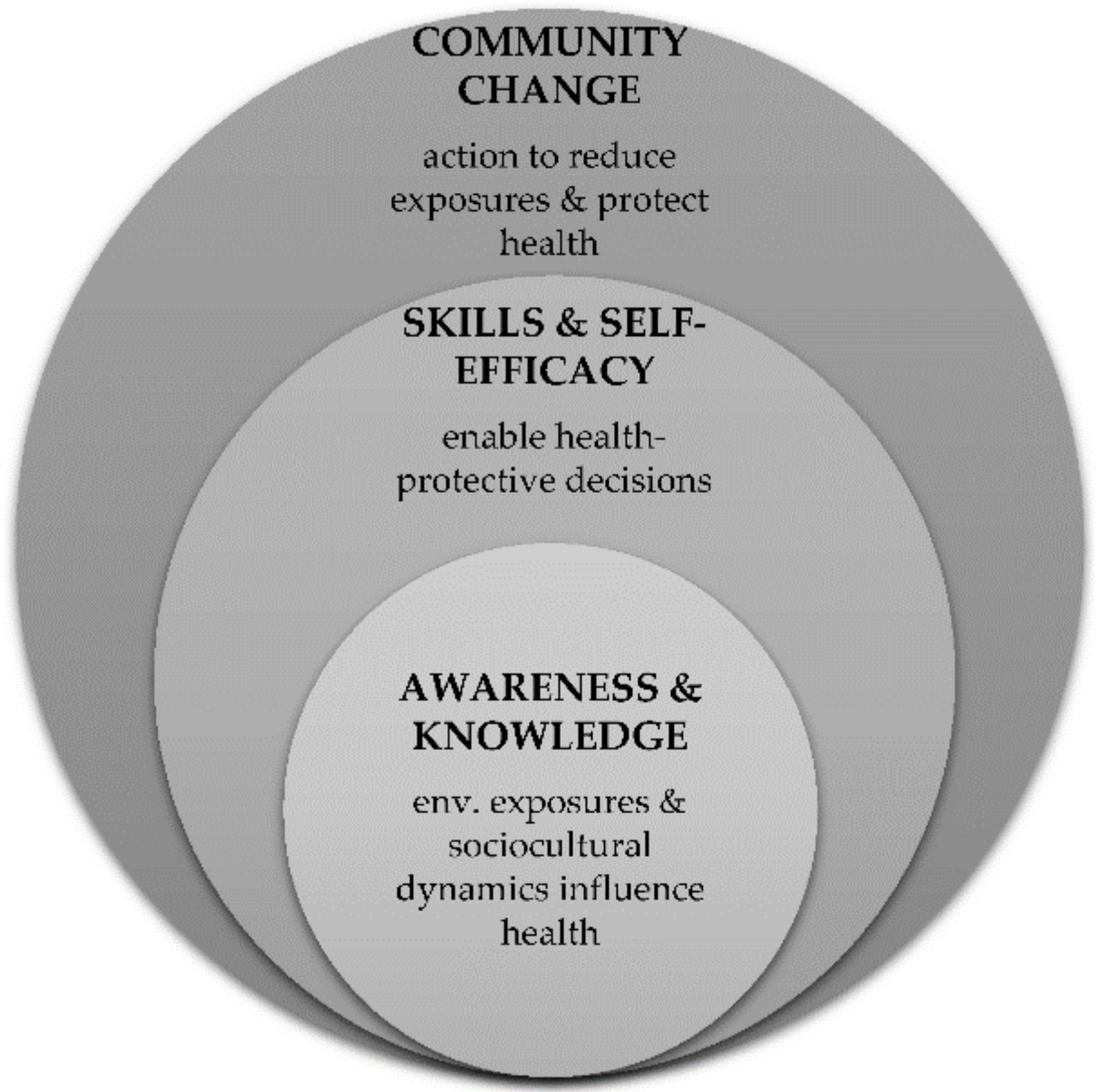
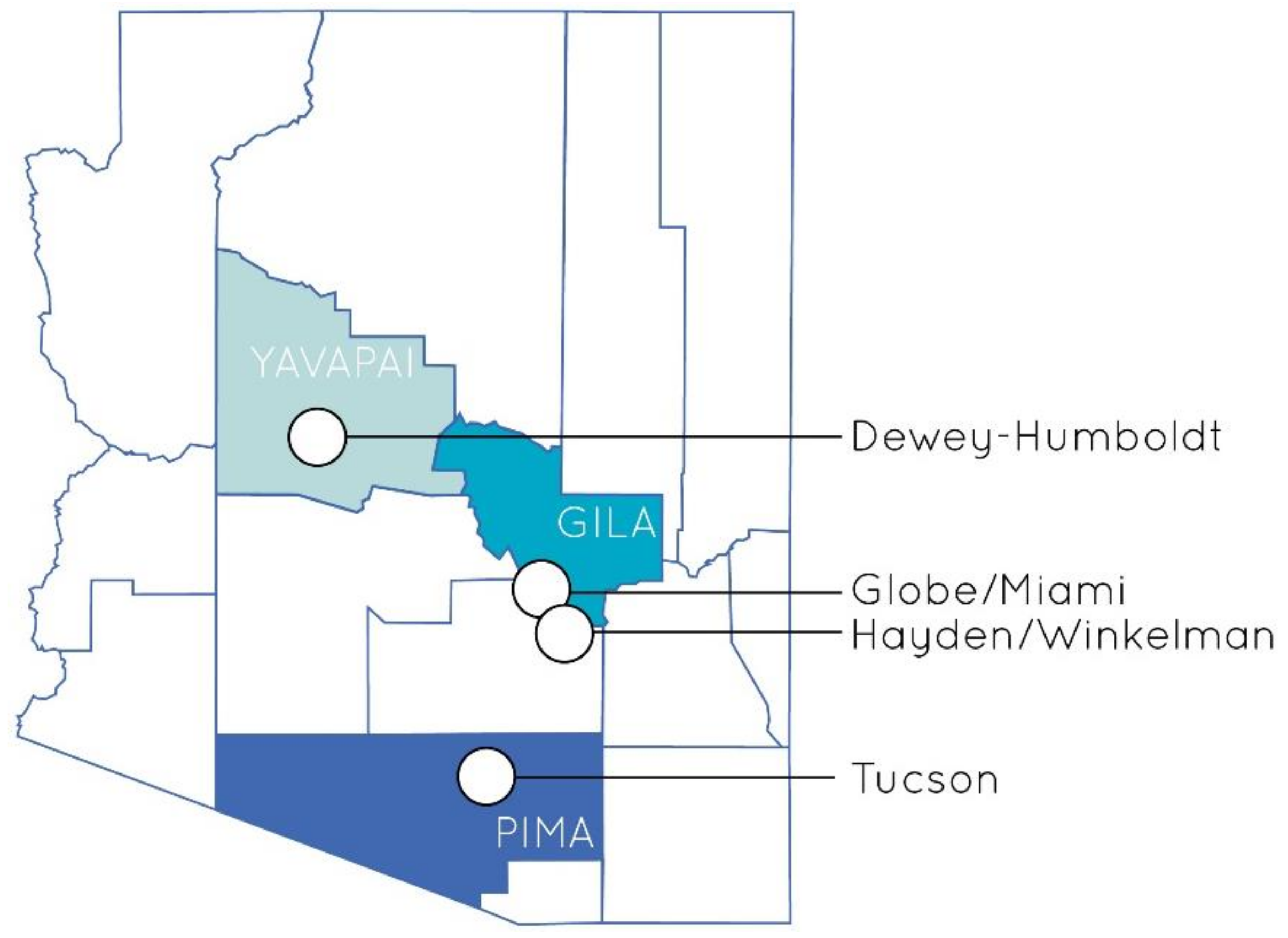
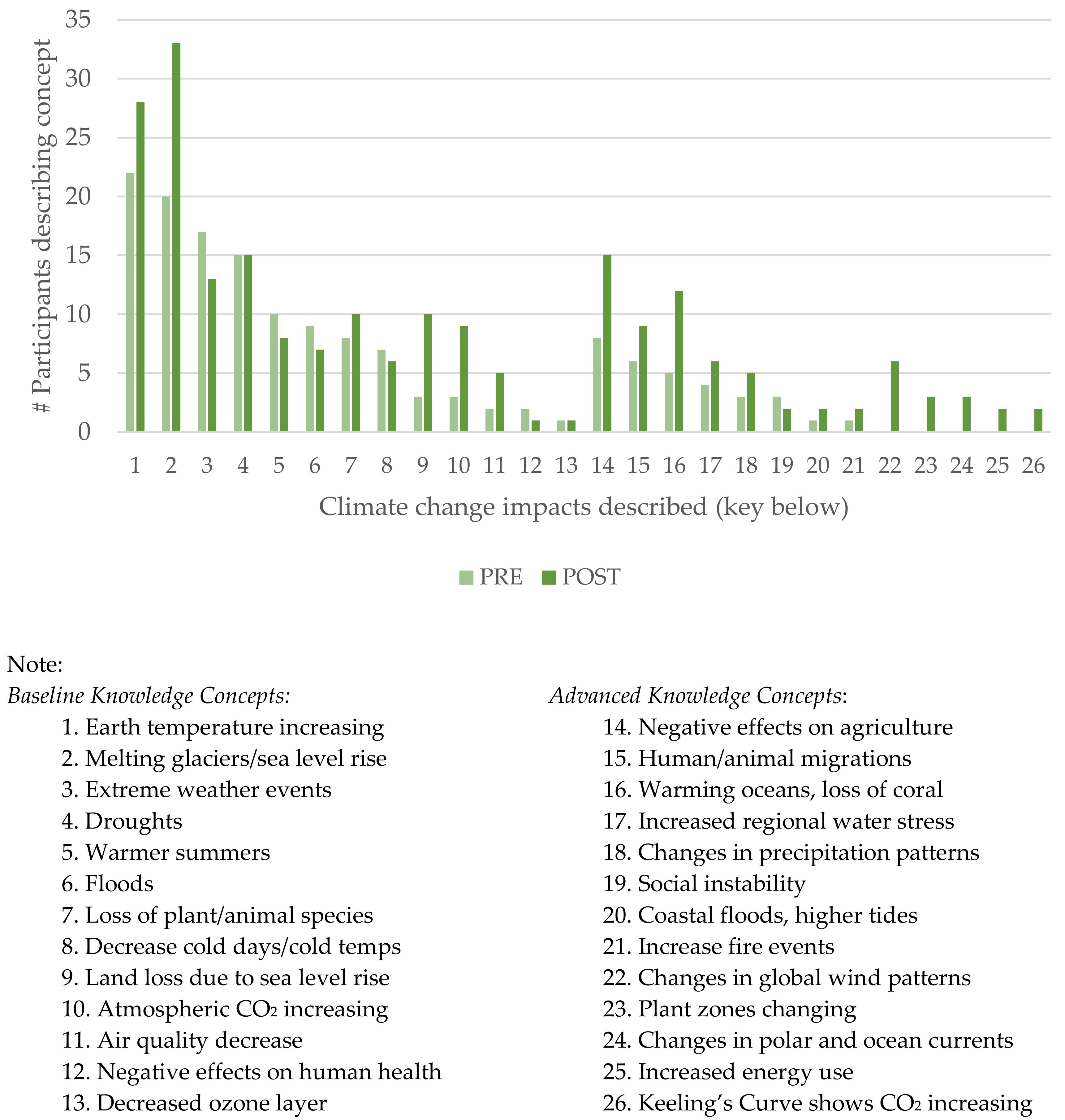
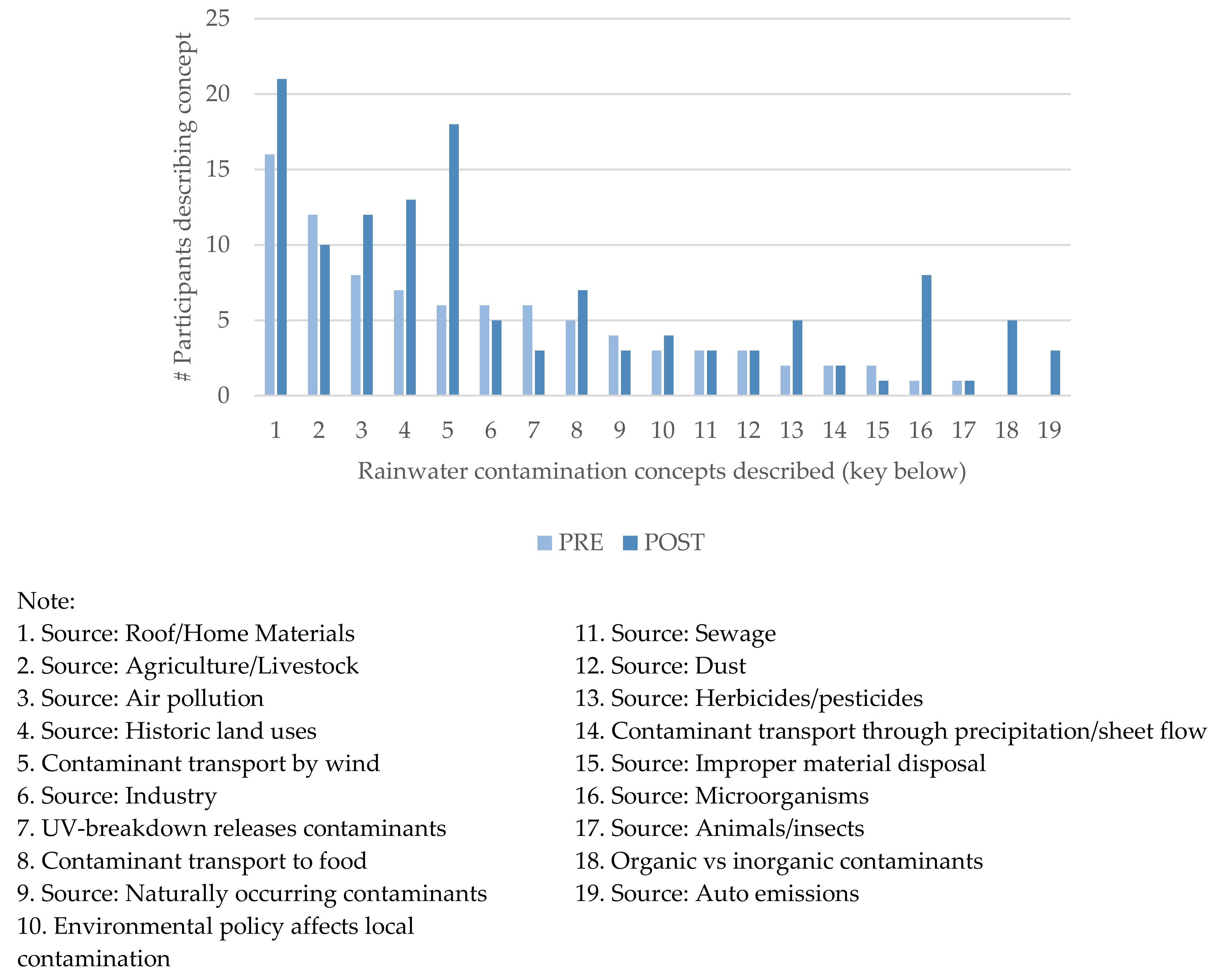
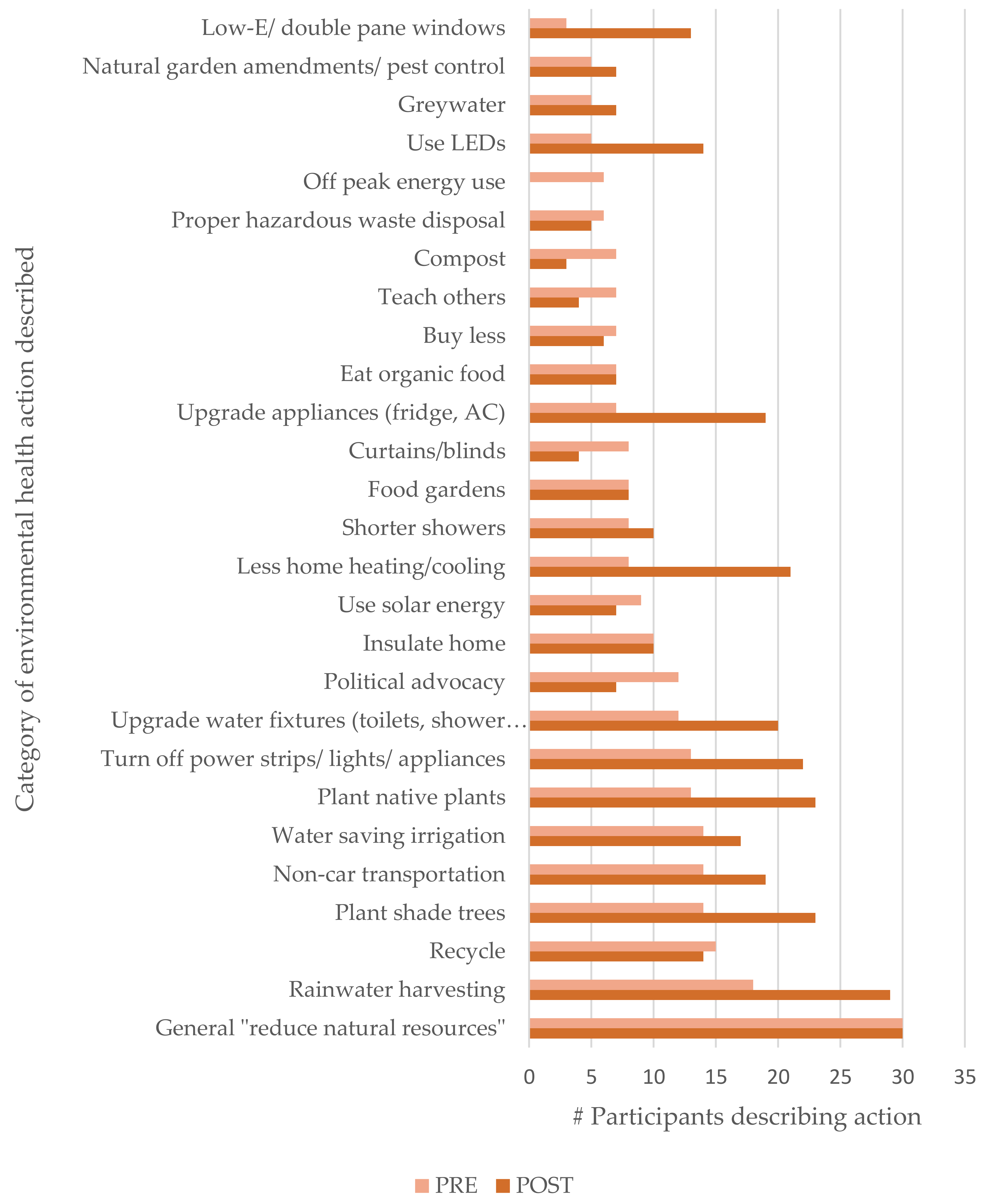
| City/Town and County | Population 1 | Median Household Income 2 | Predominant Races/Ethnicities Represented 1 | % Spanish-Speaking Households 2 | Sources of Environmental Health Risk Recognized by Community 5 | Prior/Current Partnerships |
|---|---|---|---|---|---|---|
| Tucson, Pima | 520,116 | $37,973 | White, not Hispanic/Latino: 47.2% Hispanic/Latino: 41.6 | 28.8 | Tucson International Airport Area Superfund Site [29], where aircraft and electronics manufacturing, fire drill training, and an unlined landfill have contributed trichloroethylene (TCE) and other contaminants observed in soil, groundwater, and municipal water [30,31] | Prior collaboration with non-profit organization Sonoran Environmental Research Institute (SERI), a community participatory research institute with extensive experience working with low-income Tucsonans around environmental health issues |
| Hayden 3, Gila | 662 | $36,094 | Hispanic/Latino (of any race): 84.4% | 61.8 | ASARCO Hayden Plant Alternative Superfund Site, which includes the ASARCO smelter, concentrator, former Kennecott smelter and all associated tailings facilities [32] In 2016, ASARCO was involved in a $150 million settlement with the US Department of Justice and US Environmental Protection Agency for violations of the Clean Air Act [33] | National Institute of Environmental Health Sciences Superfund Research Program partnership School superintendent enthusiastic about gardening and rainwater harvesting served as local “champion” [34] to involve teachers and students in environmental health learning |
| Winkelman 3, Gila | 353 | $45,000 | Hispanic/Latino (of any race): 84.2% | 55.6 | ||
| Globe 4, Gila | 7532 | $42,557 | White, not Hispanic/Latino: 55.3% Hispanic/Latino (of any race): 36.8% | 14.9 | Active copper smelter, rod mill, and open pit mine in Miami [35] The Mountain View Mobile Home Estates in Globe, AZ, sits on the site of a former chrysotile asbestos mill. This site was on the Superfund Program’s National Priorities List (NPL) due to asbestos contamination of soil and groundwater until clean-up activities were completed in 1988 [36] | Gila County Cooperative Extension agent became a local “champion” for environmental health learning [34], and successfully spread the enthusiasm to the Globe-Miami community |
| Miami 4, Gila | 1837 | $36,298 | Hispanic/Latino (of any race): 56% White, not Hispanic/Latino: 40.6% | 23.6 | ||
| Dewey-Humboldt, Yavapai | 3894 | $50,173 | White, not Hispanic/Latino: 85.5% | 5.2 | Iron King Mine—Humboldt Smelter Superfund Site, which includes approximately four million cubic meters of mine tailings from legacy mine and smelter [37] 2012–2013 analyses of drinking water in local homes demonstrated arsenic above the US EPA drinking water standard (10 µg/L) [38] | Community members participated in past UA research projects: 1. Citizen science project Gardenroots related to soil contamination and backyard food gardens [11,39,40,41] 2. Biomonitoring project related to metal exposure in homes [42] |
| Engagement Activity | Tucson | Hayden/Winkelman | Globe/Miami | Dewey-Humboldt |
|---|---|---|---|---|
| Press Releases | X | X | X | |
| Local Newspaper | X | X | X | |
| Town Newsletter | X | |||
| Cooperative Extension | X | X | X | |
| Master Gardeners | X | X | X | X |
| Federal Superfund Site Meetings | X | X | X | |
| Community Advisory Boards | X | X | X | |
| School Superintendent & Teachers | X | X | X | |
| SERI participants | X | |||
| City of Tucson Water program participants | X |
| Research goal: Gain understanding about training participants’ (1) initial motivation to learn about environmental health, and (2) attitude towards the environment. | ||
| Assessment Category | Data | Survey Responses Coded for: |
| 1. Motivation to learn | Four short-answer questions (pre-survey only) | Themes (qualitative) |
| 2. Attitude towards the environment | Two multiple choice questions (pre- and post-survey) | Level of pro-environmental attitude (quantitative) |
| Research goal: Measure change in training participant EHL, as comprised of (3) environmental science knowledge, (4) skills and (5) motivation for environmental health action, (6) self-efficacy, and (7) community action for systemic change. | ||
| Assessment Category | Data | Survey Responses Coded for: |
| 3. Environmental science knowledge | Four multiple choice questions, one matching question, one rank order question, seven short answer questions (pre- and post-survey) | Level of understanding (quantitative), and for themes in specific knowledge concepts (qualitative) |
| 4. Skills for environmental health | One multiple choice question, three short answer questions (pre- and post-survey) | Level of knowledge (quantitative), and for themes in specific knowledge concepts (qualitative) |
| 5. Motivation for environmental action | Eleven Likert-scale items (pre- and post-survey) | Level of motivation (quantitative) |
| 6. Self-efficacy (SE) | Six Likert-scale items measure SE for learning science, four items measure SE for doing science, twelve items measure SE for environmental action (pre- and post-survey) | Level of self-efficacy (quantitative) |
| 7. Community change | Two short answer questions (pre- and post-survey) one short answer question (post-survey only) facilitator-scientist survey responses | Themes of political advocacy, teaching others, meeting/talking/networking with others, or other collective strategies. 1 |
| Research goal: Gain understanding of (8) training participants’ experiences in the training, and (9) facilitator-scientists’ experiences in the training. | ||
| Assessment Category | Data | Survey Responses Coded for: |
| 8. Participant experience | Three short answer questions (post-survey only) | Themes (qualitative) |
| 9. Facilitator-scientist experience | Open-ended survey conducted via email with a subset of the facilitator-scientists | Themes (qualitative) |
| Code | 0—No Knowledge | 1—Partial Knowledge | 2—Baseline Knowledge | 3—Advanced Knowledge |
|---|---|---|---|---|
| Coding Rule | Response is blank or reflects no knowledge of key concepts. | Response suggests some correct knowledge of topic but does not identify key concept. | Response describes key concept and is otherwise correct. | Response describes key concept with higher complexity or details. |
| Example question: How is the use of energy derived from coal (electricity) and climate change related? | ||||
| Example Response | “Climate Change is the Glaciers melting, Didn’t understand!” | “Dirty air and chemicals from burning coal” | “Increase in CO2 green house gases” | “Burning of fossil fuels is the main contributor of rapidly increasing atmospheric CO2” |
| Survey Question # and Content | Mean Pre-Training Score 1 | Mean Post-Training Score 1 |
|---|---|---|
| 1. Greenhouse gases | 1.37 | 1.45 |
| 2–4. Impacts of climate change | 1.79 | 2.42 * |
| 6. Fossil fuel use impacts | 1.00 | 1.74 * |
| 8. Scientific method 2 | 0.84 | 0.87 |
| 9. Contaminant transport 2 | 0.92 | 0.97 |
| 10. Soil composition 2 | 0.95 | 0.97 |
| 14–16. Soil/water contamination | 1.87 | 2.23 |
| 17a. Chemical concentrations | 1.45 | 2.32 * |
| 17b. Chemical concentrations | 0.92 | 2.05 * |
| Survey Question # and Content | Below- Baseline Participant n | Mean Pre-Training Score 1 | Mean Post-Training Score 1 |
|---|---|---|---|
| 1. Greenhouse gases | 20 | 0.80 | 1.10 |
| 2–4. Impacts of climate change | 13 | 0.77 | 1.92 * |
| 6. Fossil fuel use impacts | 27 | 0.37 | 1.44 * |
| 14–16. Soil/water contamination | 13 | 0.31 | 1.85 * |
| 17a. Chemical concentrations | 21 | 0.24 | 2.10 * |
| 17b. Chemical concentrations | 32 | 0.22 | 1.88 * |
| Self-Efficacy (SE) Type | Mean Pre | Mean Post |
|---|---|---|
| SE for learning science | 2.70 | 3.76 * |
| SE for doing science | 2.63 | 3.47 * |
| SE for environmental action | 3.53 | 4.00 * |
| Type of Community Action | Examples |
|---|---|
| Political/Social Advocacy | “Learn, listen, and organize with people & neighborhood” —Tucson participant “f possible share emails to be able to get in touch with others” —Tucson participant “Call political representatives to let them know we need to keep the EPA intact”—Globe/Miami participant |
| Teach Others | “Networking, collaboration and information to help educate others in our community including in our school garden program” —Dewey-Humboldt participant “So much info! Shared with grandparents who already harvest water” —Hayden/Winkelman participant |
© 2018 by the authors. Licensee MDPI, Basel, Switzerland. This article is an open access article distributed under the terms and conditions of the Creative Commons Attribution (CC BY) license (http://creativecommons.org/licenses/by/4.0/).
Share and Cite
Davis, L.F.; Ramirez-Andreotta, M.D.; McLain, J.E.T.; Kilungo, A.; Abrell, L.; Buxner, S. Increasing Environmental Health Literacy through Contextual Learning in Communities at Risk. Int. J. Environ. Res. Public Health 2018, 15, 2203. https://doi.org/10.3390/ijerph15102203
Davis LF, Ramirez-Andreotta MD, McLain JET, Kilungo A, Abrell L, Buxner S. Increasing Environmental Health Literacy through Contextual Learning in Communities at Risk. International Journal of Environmental Research and Public Health. 2018; 15(10):2203. https://doi.org/10.3390/ijerph15102203
Chicago/Turabian StyleDavis, Leona F., Mónica D. Ramirez-Andreotta, Jean E. T. McLain, Aminata Kilungo, Leif Abrell, and Sanlyn Buxner. 2018. "Increasing Environmental Health Literacy through Contextual Learning in Communities at Risk" International Journal of Environmental Research and Public Health 15, no. 10: 2203. https://doi.org/10.3390/ijerph15102203
APA StyleDavis, L. F., Ramirez-Andreotta, M. D., McLain, J. E. T., Kilungo, A., Abrell, L., & Buxner, S. (2018). Increasing Environmental Health Literacy through Contextual Learning in Communities at Risk. International Journal of Environmental Research and Public Health, 15(10), 2203. https://doi.org/10.3390/ijerph15102203




